“No Holes, No Gas Chamber(s)”
A Historical-Technical Study of the Holes in the Roof of Morgue 1 of Krematorium II at Birkenau for Introducing Zyklon B
When American expert for execution techniques Fredrick A. Leuchter presented his famous expert report on the gas chambers of Auschwitz and Majdanek to a Canadian court in 1988, he initially caused confusion: in his technical drawings of the morgues no. 1 of the crematoria II and III of Auschwitz-Birkenau, which allegedly served as “gas chambers,” he had drawn in four openings in the roof, through which, according to witnesses accounts, the insecticide Zyklon B had been poured in order to kill hundreds of thousands of victims. It was only in a later edition of this expert report that Leuchter added a letter to the report, in which he explained that those four holes could not be found in the ruins of those crematoria.
The Swede Ditlieb Felderer was the first, in the 1970s, to raise the question whether or not there were any holes on those roofs, without which those basements could not have served as execution chambers in the way as testified to by witnesses. Ever since then, this issue has been discussed intensely. Up to the current paper, this topic was most thoroughly treated by Germar Rudolf in his Rudolf-Report. Inspired by Rudolf’s arguments, Charles D. Provan compiled a study, which is analyzed by Carlo Mattogno in the following paper. Provan’s study is based primarily on illustrations of the roof of this morgue as it looked like in 2000, but since the copies we received are of an inferior quality, we could not reproduce his study in this journal. To summarize Provan, he thinks that he has identified at least three holes in the roof of morgue no. 1 of crematorium II in Birkenau, which could have served as introduction holes in 1943/1944. Provan concludes therefore that the quip coined by Prof. Dr. Robert Faurisson, and supported by G. Rudolf with evidence, – “No Holes, no Holocaust” – is untenable. Carlo Mattogno shows in the following that Provan’s assertions themselves are untenable. All of his alleged holes are demonstrably the result of the destruction of the crematoriums during the retreat of German troops or were created only after war’s end.
1. Introduction
Charles D. Provan is the author of a pamphlet entitled, “No Holes? No Holocaust?[1] A Study of the Holes in the Roof of morgue 1 of Krematorium 2 at Birkenau.”[2]
First of all Provan emphasizes the importance of the problem of the holes for the introduction of Zyklon B into the presumed homicidal gas chamber of crematorium II. This question, raised by historical revisionists, obtained much prominence last year during the trial David Irving versus Penguin Books Ltd. and Deborah E. Lipstadt. It was also discussed by Justice Gray in the written verdict.[3]
In his study, Provan analyzes the five categories comprising the evidence for these presumed holes, which are generally accepted by the supporters of the thesis of gas chambers at Auschwitz-Birkenau:
- Witnesses and early historical testimony
- Aerial photographic evidence of the holes in the roofs of the gas chambers
- The blueprints of morgue 1, Krematorium 2
- German wartime photographs of morgue 1 of Krematoria 2 and 3
- Physical evidence
In the first category Provan cites 16 testimonies from 9 major witnesses and 7 minor witnesses (pp. 3-9).
He then examines the statements of minor witnesses (pp. 10f.) in the following order: Egon Ochshorn, Dr. Friedmann, Janda Weiss, Rudolf Vrba and Alfred Wetzler, Ota Kraus and Erich Kulka, Werner Krumme and Alfred Franke-Gricksch. Provan concludes that these are unreliable. For the major witnesses (in order, Rudolf Höss, Henryk Tauber, Karl Schultze, Salmen Lewental, Konrad Morgen, Miklos Nyiszli, Paul Bendel, Josef Erber and Filip Müller – all of whom were “eyewitnesses”), Provan provides no analysis: he assumes a priori that these are reliable. But these testimonies are in fact dubious as well, as we shall subsequently see.
As to the rest, Provan bases his arguments on only four testimonies:
- Henryk Tauber for the arrangement and number of holes for the introduction of Zyklon B (two on the east side and two on the west side of morgue 1).
- Karl Schultze for the dimensions of the holes (cm 25 cm × 25 cm).
- Konrad Morgen for the crudeness of the extermination facilities.
- Rudolf Höss for the transformation of the crematoria into instruments of mass extermination without the knowledge of the head of the Central Construction Office.
The other testimonies served as confirmation of these four principal views.
Before examining in detail Provan’s arguments, let us verify the credibility of the major witnesses cited by him.
2. The Major Witnesses Cited by Provan
Josef Erber
This testimony is cited by Provan and dealt with by Gerald Fleming in his book Hitler and the Final Solution.[4] The text cited by Fleming is taken in turn from a letter that Josef Erber wrote to him on September 14, 1981.[5] The declaration of the witness is therefore already suspect on account of the date. In the first edition of the above book, which appeared in German with the title Hitler und die Endlösung,[6] Fleming quotes from the original text of Erber’s letter:[7]
“Two inpours [Einschütten] were in each of these gassing rooms (of Krematorium one and two in Birkenau, G.F.): inside four iron pipes each from the floor to the roof. These were surrounded by steel wire mesh, and inside was a sheet metal with a low edge. To this a wire was attached, with which the sheet metal could be pulled up to the roof. An iron lid was attached to each inpour [Einschütte] at the roof. If the lid was raised, the tin container could be pulled up and the gas could be poured in. Then the container was lowered and the lid closed.”
What sort of thing is an “inpour” (Einschütte)? The verb “einschütten” means “pour in(to)” as a technical term; “to feed,” “to charge or load.” If, as it seems, the “Einschütte” was a mechanism, it must concern a device for pouring or feeding. Yet, according to the text, there were two “Einschütten” in each “gas chamber” of crematoria II and III and on the inside of each “Einschütte” there were four “iron pipes.” Therefore, in each “gas chamber” there were eight “iron pipes.” These devices are clearly inconsistent with those described by Henryk Tauber, and moreover it is difficult to imagine how they were made. So difficult is it that Provan himself, in order to make the text intelligible, wrote “rooms” (note 24 on p. 7) where Fleming, translating the German term “Einschütten,” wrote “ducts.” Even so, the original text categorically excludes this interpretation.
In conclusion, the testimony of Josef Erber is unreliable.
Konrad Morgen
Provan cites two statements made by this witness (p. 5). The first deals with the affidavit made by Morgen on July 13, 1946, document SS-65. There the witness states:
“In this moment, an SS man in a gas suit stepped over the outer air duct and poured a can with hydrogen cyanide into the room.”
Morgan talks about a single “air duct,” which contradicts the description accepted by Provan. The term “air duct” is moreover inappropriate in that the presumed holes for introducing Zyklon B had nothing whatsoever to do with ventilation. In crematoria II and III there were in fact a “Belüftungsschacht” (aeration duct) and an “Entlüftungsschacht” (de-aeration duct) which connected morgue no. 1 to the ventilators, blowing and drawing, and situated in the attic of the structures.[8] The second citation is inferred from the deposition of Morgen at the trial of Oswald Pohl. The witness confirms here that Zyklon B was introduced into the “gas chamber” through a “special shaft” (p. 5): again, a single introduction device.
How reliable this witness is for the presumed “gas chambers” becomes clear upon examining what he declared during the August 8, 1946, hearing of the Nuremberg trial:[9]
“By ‘Extermination Camp Auschwitz’ I did not mean the concentration camp. It did not exist there. I meant a separate extermination camp near Auschwitz, called ‘Monowitz.’”
A little later he confirmed this:[10]
“These trucks drove off, but they did not drive to the Concentration Camp Auschwitz, but in another direction to the Extermination Camp Monowitz, which was a few kilometers away.”
One could imagine a slip of the tongue: Morgen was thinking of Birkenau but said Monowitz. But that he was thinking literally of Monowitz is revealed by the following statement:[11]
“The Extermination Camp Monowitz lay far away from the concentration camp. It was situated on an extensive industrial site and was not recognizable as such and everywhere on the horizon there were smoking chimneys.”
In fact, there is no doubt about it: in an “extensive industrial site” full of chimneys, he found Monowitz, certainly not Birkenau. Now if Konrad Morgen is an “eyewitness,” how could he confuse Birkenau with Monowitz? It seems that he had seen precisely nothing, but spoke – for the most part incoherently – from hearsay. Therefore, as far as we are concerned, Konrad Morgen is a completely unreliable witness.
Paul Bendel
Provan cites via Pressac the short text “Les Crématoires. ‘Le Sonderkommando’” carrying the signature “Paul Bendel,”[12] which appeared in a book published in 1946. Here the author states that the “chambres à gaz” (“gas chambers”) in each of crematoria II and III were “au nombre de deux” (“in number two”) and adds:[13]
“Made of reinforced concrete, one had the impression when entering that the ceiling would fall on one’s head, so low it was. In the middle of these chambers two pipes surrounded by wire mesh and with an exterior valve served for the emission of gases.”
Provan notices that the presence of two gas chambers is in accord with the declaration of Tauber, according to whom “at the end of 1943, the gas chamber was divided into two by a brick wall to make it possible to gas smaller transports.” (note 20 on p. 6)
Therefore Bendel would confirm Tauber. However, matters are not that simple.
It is known that the morgue no. 1 of the crematria II and III measured internally 30 m × 7 m × 2.41 m.[14] At the trial of Bruno Tesch, Bendel testified that “each gas chamber was 10 meters long and 4 meters wide” and that each had a height of 1.60 m:[15]
“Q. You have said that the gas chambers were ten meters by four meters by one meter sixty centimeters: is that correct? A. Yes.”
Previously, on 21 October 1945 Bendel had declared:[16]
“There were 2 gas chambers, underground, roughly 10 meters long, 5 meters wide and 1 ½ meters high, each one.”
Nevertheless, even if morgue 1 of the crematoria II and III had been divided exactly in two, this would have given rise to two localities each measuring 15 m × 7 m × 2.41 m. How can these measurements be reconciled with the quite different ones given by Bendel, that is, 10 m × 4 m × 1.6 m or 10 m × 5 m × 1.5 m?
I well understand that an estimate with the naked eye can be subject to a considerable margin of error, but how could Bendel claim that the ceiling had a height of barely 1.5 or 1.6 m? Here we are no longer dealing with an estimate since any person of medium height would have had to stoop in order to enter these fictitious places; in the actual localities, however, he would have had more than 60 to 70 cm of space above his head before touching the ceiling. An error in good faith is therefore impossible. But even the errors relative to the length and breadth of the localities, considering their modest dimensions, are difficult to explain.
Whatever the case, it is impossible for Bendel to have entered a “gas chamber” with a height of 1.5 or 1.6 m since such localities did not exist and it is just as impossible that he could have made such a gross error; therefore he is an unreliable witness.
Strangely, Bendel makes no mention of the presumed “undressing room” (morgue no. 2), even though it had a ceiling 11 cm lower than that of morgue 1![17]
Miklos Nyiszli
Provan cites two passages from the statements of this witness (pp. 5f.). The first goes back to July 28, 1945, and the other to October 8, 1946. Nyiszli mentions four “ventilation valves” equipped with “perforated tubes” which popped out above the “gas chamber” of crematorium II in “concrete chimneys” closed with “concrete lids.” “Chlorine gas” was introduced into these “valves.”
In 1946 Nyiszli published a book of memoirs in Hungarian with the title I was Dr. Mengele’s Anatomist at an Auschwitz Crematorium,[18] of which there was an English translation published in the USA. Among other things it contains an detailed description of the basement of crematorium II:[19]
“The room[20] into which the convoy proceeded was about 200 meters long:[21] its walls were whitewashed and it was brightly lit. […].
Making his way through the crowd, an SS opened the swing-doors of the large oaken gate at the end of the room. The crowd flowed through it into another, equally well-lighted room. This second room[22] was the same size as the first[23] but neither benches nor pegs were to be seen. In the center of the rooms, at thirty-yard intervals, columns rose from the concrete floor to the ceiling. They were not supporting columns, but square sheet-iron pipes, the sides of which contained numerous perforations, like a wire lattice. […]
The Deputy Health Officer held four green sheet-iron canisters. He advanced across the grass, where, every thirty yards,[24] short concrete pipes jutted up from the ground. Having donned his gas mask, he lifted the lid of the pipe, which was also made of concrete. He opened one of the cans and poured the contents – a mauve granulated material – into the opening. The granulated substance fell in a lump to the bottom. The gas it produced escaped through the perforations, and within a few seconds filled the room in which the deportees were stacked. Within five minutes everybody was dead.”
The English translation omits the following phrase from the last passage:[25]
“A beszórt anyag Cyclon, vagy Chlór szemcsés formája, azonnal gázt fejleszt, amint a levegövel érintkezik!”
That is:
“The scattered substance is Cyclon or chlorine in granular form, the gas develops immediately, hardly coming into contact with air!”
Let us recapitulate.
Miklos Nyiszli, in contradiction to the plans and the ruins of the crematoria, maintains that morgue 2 had a length of 200 meters, while in reality it measured 49.49m,[26] and that likewise morgue 1 had a length of 200 meters, while in fact its length was 30 meters. In the “gas chamber” there were four devices for the introduction of Zyklon B, but they were separated from each other by 30 meters – the entire length of the site!
Perhaps the omission in the English translation of the above passage from the original Hungarian happened by chance, but the fact remains that it gives rise to another absurdity: as everyone knows, the toxic agent of Zyklon B was not chlorine, but rather hydrogen cyanide.
The description given by witness Nyiszli presents many more incredible blunders. For example, he maintains that there were four elevators in the basement of crematorium II:[27]
“Four good-sized elevators were functioning [here]”
It is well known that there was but a single elevator.
In addition, he maintains that in the furnace room of crematorium II there were 15 single ovens:[28]
“Each of these fifteen ovens was housed in a red brick structure.”
In crematorium II (and III) there were in fact 5 ovens, each with 3 muffles, and so there were five brick structures, not fifteen.
Nyszli claims to have spent eight months[29] (from May 1944 to January 1945) in the so-called “Sonderkommando” of the crematoria; that is, for six months his lodging was located on the ground floor of crematorium II.[30] He should then have had a perfect knowledge of crematorium II. So how could he have been so grossly mistaken in good faith about the dimensions of the facilities, the number of elevators and the structure of the ovens? And, since he was a medical man who presumably assisted at various “gassings,” how could he maintain that the toxic agent of Zyklon B was chlorine?
It is therefore evident that this witness is absolutely unreliable.[31]
A final observation: according to Nyiszli there was a single gas chamber in crematorium II, while according to Tauber the “gas chamber” was subdivided into two at the end of 1943. On the other hand, there is the witness Bendel, who, in his own words, became a member of the so-called “Sonderkommando” of the crematoria in June 1944.[32] In the same period and in the same place, Bendel “saw” two “gas chambers” of 10 meters’ length, while Nyiszli saw one “gas chamber” there of 200 meters’ length. How can these statements be reconciled?
Filip Müller
The testimony of Filip Müller is pitifully late, going back only to 1979. He describes in the following way the devices for the introduction of Zyklon B:[33]
“The Zyklon B gas crystals[34] were thrown through openings in the concrete ceiling, which ended in hollow sheet metal columns in the gas chamber. These were perforated equidistantly, and inside of them a spiral ran from top to bottom, to achieve a distribution of the grainy crystals as equally as possible.”
This description is very vague. Müller indicates neither the number nor the shape nor the dimensions nor the positions of either the holes or the columns. This last point takes on major significance from the fact that Filip Müller published a plan of crematorium II complete with “criminal” captions:[35] an excellent but lost opportunity to indicate the positions of the holes in the ceiling of morgue 1!
From such a witness, who claims to have spent “three years in the crematoria and gas chambers of Auschwitz” (as the subtitle of his book informs us), one expects something better than this dull description.
But this should not surprise us. As I have indicated elsewhere, here as in many other important places of his book, Filip Müller has done no more than plagiarize the account given by Miklos Nyiszli, of which the German translation appeared in 1961 in the magazine Quick published in Munich, Bavaria.[36]
In this specific case Müller has added on his own the odd idea of the spiral – as though Zyklon B could evaporate during the few seconds it spent spiraling down this chute before arriving at the long floor!
Salmen Lewenthal
This witness is even more vague than Filip Müller. From the passage cited by Provan (p. 5), one cannot even gather the number of “small upper doors.”
I will subsequently return to the witnesses Höss, Schultze and Tauber.
3. The Aerial Photographs
In paragraph III (pp. 12-14) Provan examines the photographs taken by the United States Air Force during the war. In some of the photographs of the roofs of morgue 1 of crematoria II and III, such as in the one taken on 25 August 1944, there appear irregular dark patches that – as Provan recalls – Brugioni and Poirier have interpreted since 1979 as “vents used to insert the Zyklon-B crystals.” Since then, these patches have become a “proof” of the existence of devices for introducing Zyklon B into the presumed homicidal gas chambers.
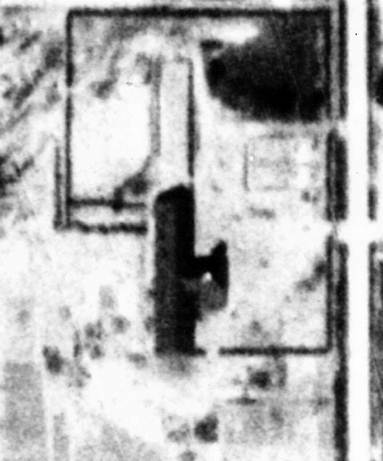
Photo 1: Allied air photo of crematorium II in Birkenau, May 31, 1944
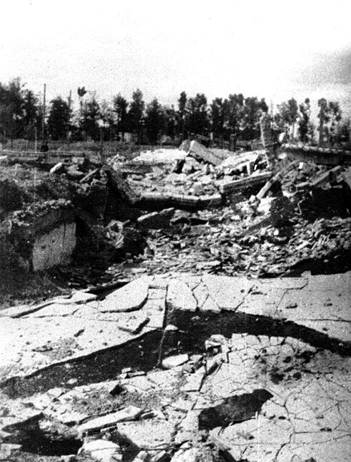
Photo 2. The reinforced concrete roof of morgue 1 of crematorium II in Birkenau in June/July 1945. Photo by Stanislaw Kolowca.
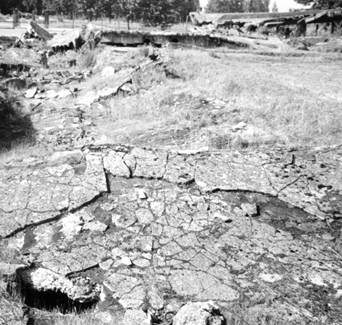
Photo 3. The reinforced concrete roof of morgue 1 of crematorium II in Birkenau in August 2000. © Carlo Mattogno
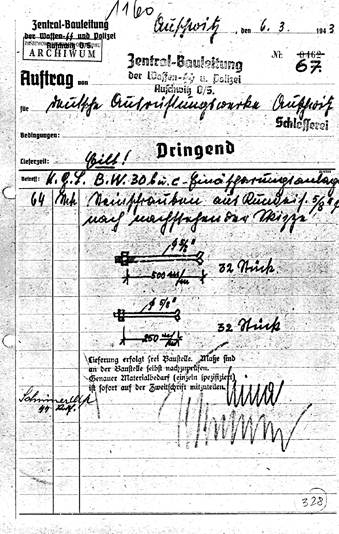
Photo 4: Order of Central Construction Office to inmate locksmith shop, no. 67 of March 6, 1943.

Photo 5: Back side of the same document.
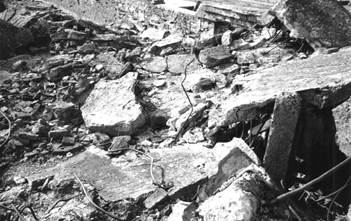
Photo 6: Round opening for the pipe of the ventilation through the reinforced concrete roof of morgue 2 of crematorium II in Birkenau. August 2000. © Carlo Mattogno.
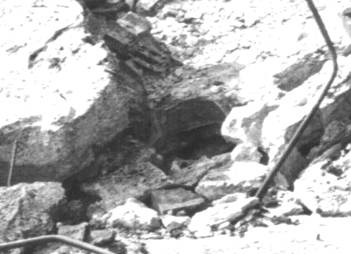
Photo 7: Round opening for the pipe of the ventilation through the reinforced concrete roof of morgue 2 of crematorium II in Birkenau. Section enlargement of Photo 6. © Carlo Mattogno
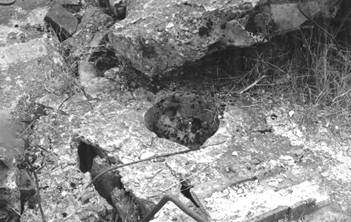
Photo 8: Round opening for the pipe of the ventilation through the reinforced concrete roof of morgue 2 of crematorium II in Birkenau. October 1991. © Carlo Mattogno
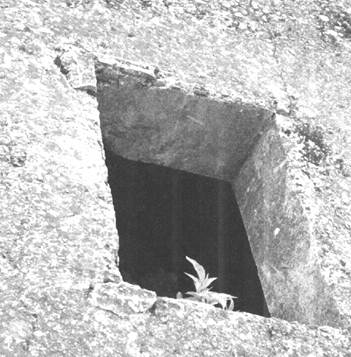
Photo 9: Ceiling of the oven room of crematorium III. First ventilation opening (seen from the west). June 1990. © Carlo Mattogno

Photo 10: Ceiling of the oven room of crematorium III. Second ventilation opening (seen from the west). June 1990. © Carlo Mattogno
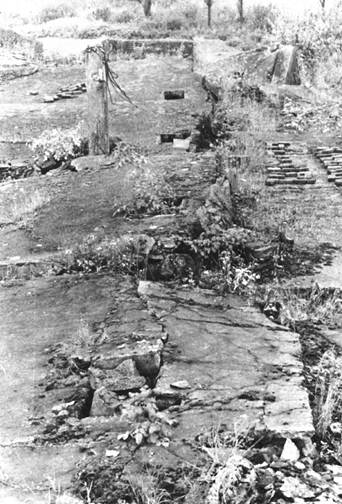
Photo 11: All five ventilation openings of the ceiling of the oven room of crematorium III . Photo by J.-C. Pressac.
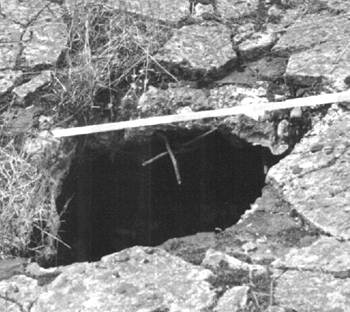
Photo 13: Concrete roof of morgue 1 of crematorium II in Birkenau. Opening 2 in June 1990. © Carlo Mattogno
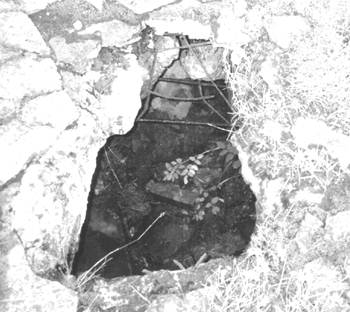
Photo 14: Concrete roof of morgue 1 of crematorium II in Birkenau. Opening 2 in July 1992. © Carlo Mattogno

Photo 15: Concrete roof of morgue 1 of crematorium II in Birkenau. Opening 2 in August 1997. © Carlo Mattogno

Photo 16: Concrete roof of morgue 1 of crematorium II. Opening 2 in June-July 1945. Section enlargement of photo 2.
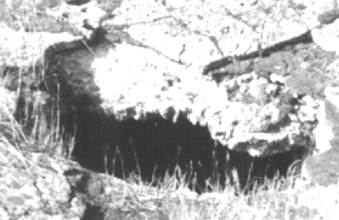
Photo 17: Concrete roof of morgue 1 of crematorium II in Birkenau. Opening 2 in July 1992. © Carlo Mattogno
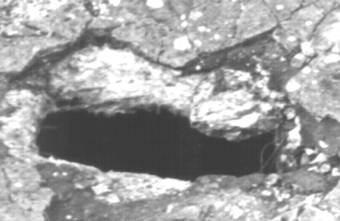
Photo 18: Concrete roof of morgue 1 of crematorium II in Birkenau. Opening 2 in August 2000. © Carlo Mattogno
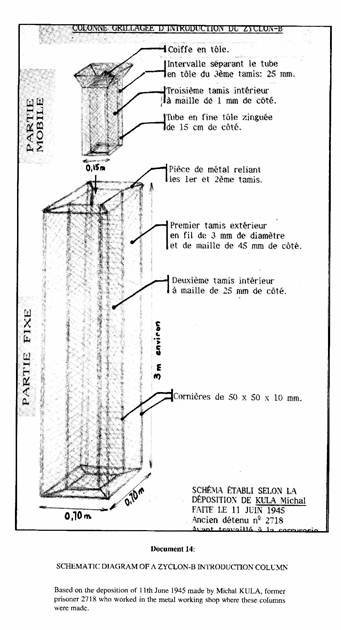
Photo 19: Drawing of Zyklon B introduction device by J.-C. Pressac, following the description of M. Kula.
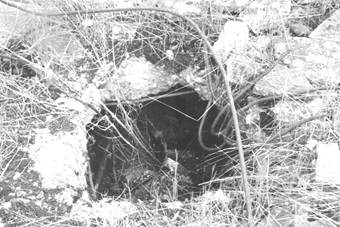
Photo 20: Concrete roof of morgue 1 of crematorium II in Birkenau. Opening 7 in June 1990.
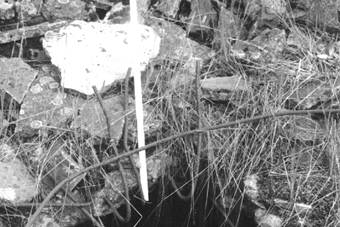
Photo 21: Concrete roof of morgue 1 of crematorium II in Birkenau. Reinforcement bars of opening 7 in June 1990.
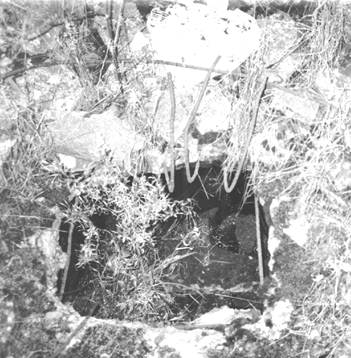
Photo 22: Concrete roof of morgue 1 of crematorium II in Birkenau. Opening 7 in October 1991. © Carlo Mattogno
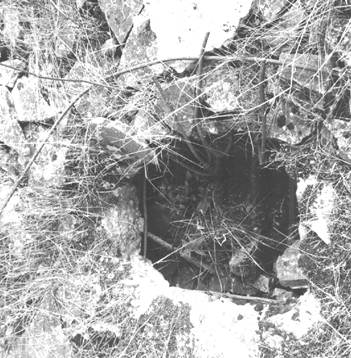
Photo 23: Concrete roof of morgue 1 of crematorium II in Birkenau. Opening 7 in July 1992. © Carlo Mattogno

Photo 24: Concrete roof of morgue 1 of crematorium II in Birkenau. Opening 7 in August 1997. © Carlo Mattogno
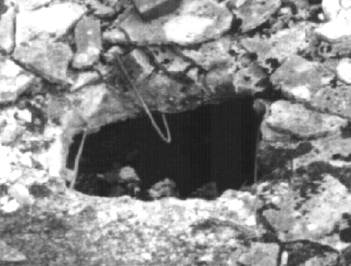
Photo 25: Concrete roof of morgue 1 of crematorium II in Birkenau. Opening 7 in August 2000. © Carlo Mattogno
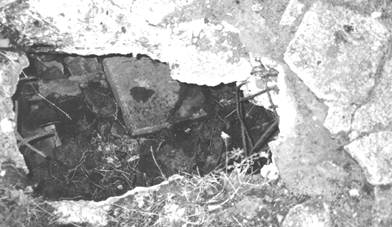
Photo 26: Concrete roof of morgue 1 of crematorium II in Birkenau. Opening 2 in October 1991. Inside the morgue on the floor a square concrete lid can be seen stemming from the sewer manhole of this crematorium.
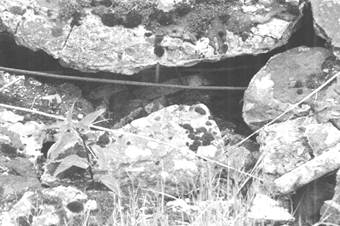
Photo 27: Concrete roof of morgue 1 of crematorium II in Birkenau. Provan’s opening no. 6 in June 1990.
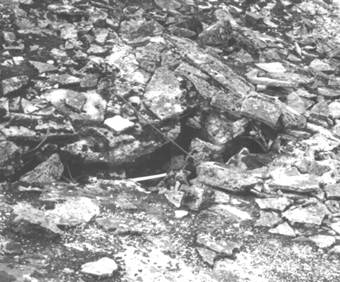
Photo 28: Concrete roof of morgue 1 of crematorium II in Birkenau. Provan’s opening no. 6 in August 2000.
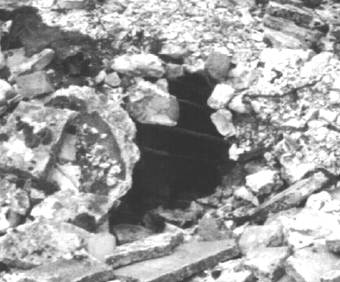
Photo 29: Concrete roof of morgue 1 of crematorium II in Birkenau. Provan’s opening no. 8 in August 2000.
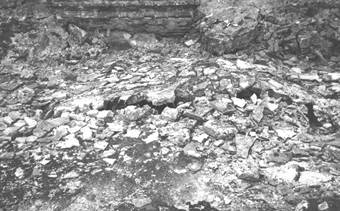
Photo 30: Concrete roof of morgue 1 of crematorium II in August 2000. Line of the crack, to which Provan’s opening no. 8 belongs – to the right of this photo (see photo 31).
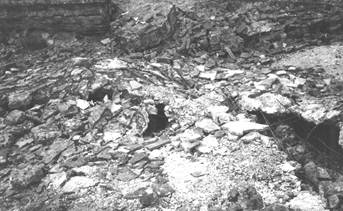
Photo 31: Concrete roof of morgue 1 of crematorium II in Birkenau in August 2000. Opening 8 (in the center) and continuation of crack (see photo 30), of which opening 8 is a part.
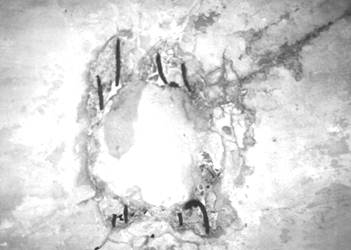
Photo 32: Ceiling of the morgue of crematorium I, August 1997. The traces of a circular opening for the ventilation of the air raid shelter.
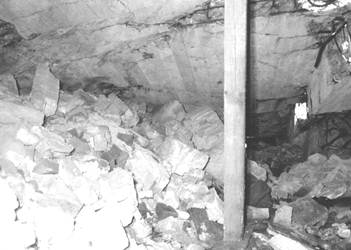
Photo 33: Inside of morgue 1 of crematorium II, July 1992.
All photos © Carlo Mattogno
Provan is not in agreement with the interpretation of Brugioni and Poirier and maintains that,
“No matter what one thinks of the authenticity of the smudgy marks, it is impossible to view them, whether authentic or not, as ‘vents.’” (p. 13)
Provan concludes:
“So we are hesitant to use the aerial photographs as proof that there were roof vents for Zyklon B.” (p. 14)
In fact, the interpretation of Brugioni and Poirier creates insuperable difficulties.
The first is that these patches are not shadows. At the second (1988) trial of Zündel, Kenneth R. Wilson, an expert in photogrammetry and aerial triangulation, testified – according to Barbara Kulaszka’s report – that in the aerial photograph of May 31, 1944, “the patches on top of the morgue at crematorium II were flat and had no elevation.” As for the photograph of August 25, 1944, “he determined that the patches were not shadows but did not have any elevation.”[37]
In the second place, as other authors have since pointed out,[38] in the photograph of August 25, 1944, the patches on the roof of morgue 1 of crematorium II have lengths of 3-4 meters, and those on the roof of morgue 1 of crematorium III have a minimum area of three square meters. Moreover, all the patches have their axis oriented in a north-south direction, whereas the axis of the chimney’s shadow is aligned in a north-east/south-west direction. Finally, let me add that in the aerial photograph of May 31, 1944, there appears a single dark patch at the western edge of the roof of morgue 1 of crematorium II.[39]
Crematorium II of Birkenau, May 31, 1944
Since the above patches were not shadows, what then were they? Kenneth R. Wilson advanced the hypothesis that they were “discolorations on the surface of the roof.”[40] John C. Ball claimed that these are not discolorations of the roof but of the negative, that is, marks that had been put onto the negative by a forger.[41]
There are, however, less radical explanations. For example, the marks may have been by some kind of flat vegetation on the roof, because the morgues were covered with earth to keep them cool. However, this does not explain why these marks are visible on some photos but not on others.
Another explanation could be that the soil covering the morgues had to be removed temporarily for reparation purposes. The roofs of morgue 1 of crematoria II and III were made of reinforced concrete 18 cm thick,[42] insulated from rainwater by a layer of bitumen which was protected from atmospheric agents by a thin layer of cement. It is conceivable that this thin layer of concrete had been damaged, resulting in leaks,[43] which could have led the Central Construction Office to have the soil removed in order to perform the reparations necessary. But it seems more likely that such a soil removal would have been done in large areas, but not in areas merely 3 m long and 1 m wide. There is also no documentary evidence for such reparation works.
A final possibility is that the morgues were not at all covered with earth at the time these photos were made, and that the marks indicate areas were the upper concrete layer had been damaged and the lower layer of black bitumen emerged, creating the patches which are seen on the aerial photographs.
4. The Plans of Morgue 1 of Crematorium II
Referring to Robert Faurisson’s discovery of the fact that the presumed gas chamber of crematorium II is designated “morgue 1” in the original plans of crematorium II in Birkenau, and that no holes in the ceiling are displayed for this locality, Provan notes:
“Though these two discoveries are important, let us observe that they are in agreement with an interrogation which took place over 50 years ago.” (p. 15)
Next Provan cites an extract from the interrogation that Rudolf Höss underwent on April 1, 1946, which he summarizes and comments upon as follows:
“Note that Höss mentioned several times that he was forbidden to discuss the execution of the Jews with anyone. Upon his return to Auschwitz he began working on the plans for extermination facilities by instructing his construction chief (whose name was Bischoff). He ordered Bischoff to begin work on a large crematorium, the plans of which were sent to Himmler. Subsequently, Höss figured out the changes needed to convert the crematorium into a homicidal facility, and sent them to Himmler. The changes were approved.” (pp. 15f.)
In concluding, he writes that the “gas chamber” was called “morgue 1” and that no holes were described for the introduction of Zyklon B:
“since the man in charge of it was not permitted to know of its real purpose, and therefore did not draw them on the plans.” (p. 16)
Provan’s conclusion is therefore based on the statements of Rudolf Höss; but are such statements reliable? To answer this question let us now examine the context in which they are placed.
Höss maintained that he received the order to exterminate the Jews in Berlin from Himmler personally in July 1941.[44] On that occasion Himmler explained that
“the extermination camps in Poland that existed at that time were not capable of performing the work assigned to them.”[45]
Then, to a specific query of the interrogator, Höss responded:
“There were three camps: first, Treblinka, Belzak [sic] near Lemberg and the third one was about 40 kilometers in the direction of Kulm. It was past Kulm in an easterly direction.”
The third “extermination camp” should have been Sobibór. Nevertheless, the geographic direction given by Höss is mistaken since “Kulm” corresponds to the Polish “Chelmno,” while the neighboring city of Sobibór is “Chelm,” which in German is called “Cholm.”
Therefore, when Höss claimed that Himmler had informed him that
“the camps in Poland were not suitable for enlargement and the reason why he had chosen Auschwitz was because of the fact it had good railroad connections and could be enlarged”[46]
and ordered him
“to look at an extermination camp in Poland and eliminate in the construction of my camp the mistakes and inefficiency existing in the Polish camp,”[47]
he understood that, according to Himmler, in July 1941 there already existed the “extermination camps” of Treblinka, Belzec and Sobibór, exactly as Höss described them during the interrogation of 14 March 1946 when he declared
“I was ordered to see Himmler in Berlin in June [sic] 1941 and he told me, approximately, the following: The Führer ordered the solution of the Jewish question in Europe. A few so-called Vernichtungslager are existing in the general government (Belzek [Belzec] near Rava Ruska Ost Polen, Tublinka [Treblinka] near Malina [Malkinia] on the river Bug, and Wolzek[48] near Lublin.”[49]
Let us now turn to the interrogation of April 1, 1946. Höss declared there that he had visited the Treblinka camp before constructing his extermination facilities at Auschwitz. The purpose of his visit was precisely to “eliminate in the construction” of his “camp the mistakes and inefficiency” of Treblinka. Höss describes at length the presumed extermination procedure at Treblinka, specifying
“at that time the action in connection with the Warsaw Ghetto was in progress, and I watched the procedure.”[50]
Also this description reproduces what Höss declared at the interrogation of March 14, 1946:[51]
“I visited the camp Treblinka in Spring 1942 to inform myself about the conditions. The following method was used in the process of extermination. Small chambers were used equipped with pipes to induce exhaust gas from car engines. This method was unreliable as the engines, coming from old captured transport vehicles and tanks, very often failed to work. Because of that the intakes could not be dealt with according to the plan, which meant to clear the Warsaw Ghetto. According to the Camp Commandant of Treblinka 80000 people have been gassed in the course of half a year.”
Rudolf Höss recounted the same story also at the interrogation of April 8, 1946:[52]
“I had the order to create extermination facilitations in Auschwitz in June 1941. At that time, three other extermination facilities already existed in the Government General: Belzek, Treblinka, and Wolzek. These camps were under the jurisdiction of the Einsatzkommando of the Security Police and the SD. I visited Treblinka to determine how the exterminations are being executed. The camp commander of Treblinka told me that he has liquidated 80,000 with half a year. His main task was the liquidation of all the Jews from the Warsaw ghetto. He used carbon monoxide gas, and according to him his method was not efficient. When I erected the extermination building in Auschwitz, I therefore used Zyclon B, a crystalline blue acid [sic], which we threw into the death chamber through small openings.”
So Höss affirmed that in June or July 1941 there were already in existence the camps of Belzec and Treblinka, and that he had visited the Treblinka camp “in Spring 1942”, but before the construction of the “extermination building” at Auschwitz; that is, at the latest before the installation of the so-called “Bunker 1” – which should have entered into service on March 20, 1942,[53] or in May 1942, according to Pressac.[54]
Nonetheless, the Belzec camp was opened on March 17, 1942,[55] and Treblinka on July 23, 1942.[56] In conclusion, these two camps did not exist in 1941; therefore the statements that Höss attributes to Himmler are false. What is more, since Höss could not have visited Treblinka before the start of the presumed extermination at Auschwitz, his account of it is false.
Thus, the declarations of Höss cited by Provan are contained in this context of manifest historical falsehood; why then should one believe in their truthfulness?
Hence the context leads one to seriously doubt the reliability of the declarations of Rudolf Höss which Provan cites.
Let us now examine the substance of Rudolf Höss’ statements. He maintains:[57]
“I immediately got in touch with the chief of a construction unit and told him that I need a large crematorium.”
This took place in June or July 1941 on his return to Auschwitz from the meeting with Himmler in Berlin. Nonetheless, the first plan of the new crematorium – the future crematorium II – was drawn up by SS-Untersturmführer Dejaco on October 24, 1941,[58] that is, three or four months later, which is hard to reconcile with the adverb “immediately.” The second plan of the crematorium was realized in November 1941 by the architect Werkmann of the SS Main Office Budget and Buildings;[59] this shows that the construction of this facility was not a local secret affair. Höss then states that he ”changed” the plans “in accordance with the real purpose” of Himmler’s instructions – that is, he modified the original plans, thus transforming a simple hygienic and sanitary facility into an instrument for extermination – and sent these plans so modified to Himmler, who approved of them.[60] The definitive plan for the crematorium was completed at Auschwitz in January 1942.[61] Yet according to Pressac, the first presumed “criminal” modification of these plans can be found in plan no. 2003 of December 19, 1942.[62] Therefore, Höss would have had to have waited twelve months before initiating the criminal modification of the crematorium! I say “initiating” because, as Provan states, the holes in the ceiling of morgue 1 of crematorium II would have been made between the end of January 1943 and the middle of March 1943 (pp. 18f), so that Höss would have had to wait at least another month before carrying out this indispensable modification in order to use the above locality as a homicidal gas chamber. I shall return to this essential point in Section VI.
On the other hand, the claim of Rudolf Höss that he created at Auschwitz installations for extermination without informing the head of the Central Construction Office beforehand is decisively nonsensical, considering our knowledge of the structure, functions and duties of this bureau.[63] This is even truer of the presumed “criminal” modifications to crematorium II. In fact, if Bischoff had transformed the so-called “Bunker 1” by May 1942 into a homicidal gas chamber (and in June the so-called “Bunker 2”), and if the mass extermination of the Jews had begun by July 4 at the latest,[64] then Himmler’s “secret” at Auschwitz was revealed and Bischoff could not but have been perfectly informed of it. If so, why then did Höss have to continue transforming crematorium II into an extermination facility, gradually and secretly, without the knowledge of Bischoff who now knew the “secret”?
All this is nonsensical; so the statements of Rudolf Höss are false also on this score.
A final observation: A further “criminal” modification of the basement of crematorium II was supposed to be the change of the entrance staircase to morgue 2. Even though this entrance was less important to the extermination process than the holes in the ceiling of morgue 1 (because the victims could enter the basement through the entrance on the north side of the crematorium),[65] this staircase modification does appear in the plan attached to the documentation on the “negotiation of handing over” of the crematorium to the Kommandantur.[66] But then why do the much more important holes for introducing Zyklon B not appear in this plan?
In conclusion, while it is true that the plans for the crematoria are “in accord with [the respective passages of] the statement of Höss” (p. 30), these “statements” are not “in accord” with historical reality; therefore Provan’s arguments are altogether untenable.
5. The Terrestrial Photographs of Morgue 1
In paragraph V, “German wartime photographs of morgue 1 of crematoria 2 and 3,” Provan analyzes the four photographs adduced by Pressac as proof of the existence of chimneys for the introduction of Zyklon B on the roof of morgue 1, and Provan comes to the conclusion that in reality these prove nothing.
Photograph 1 (negative number 20995/507 from the Auschwitz Museum):
“Try as we might, we cannot see any of these openings on the photograph.” (p. 17)
Photograph 2 (negative number 20995/494 from the Auschwitz Museum):
“It is our conclusion therefore, that whatever they are, they are not the Zyklon B insertion chimneys spoken of by the eyewitnesses.” (p. 18)
Photograph 3 (negative number 20995/460 from the Auschwitz Museum):
“Since the object, whatever it is, isn’t on the roof at all, this is conclusive evidence that it was not a Zyklon B introduction chimney.” (p. 18)
Photograph 4 (negative number 20995/506 from the Auschwitz Museum):
“The roof is covered with snow, and no vents for Zyklon B are visible. Since the picture is dated from January 20-22, 1943, we can deduce that any holes for Zyklon B insertion must have been put in after that date.” (p. 18)
To Germar Rudolf’s observation that forcing openings through the finished roof of morgue 1 “would truly be an incredibly stupid piece of bungling,”[67] Provan responds:
“We do not see why this would be so. We have already seen that Höss could not even tell his SS architect about the building’s real purpose, and we can observe that all of the blueprints call that gas chamber ‘morgue 1.’ […] So we see no problem with this method being the method of creating Zyklon B holes in the roof of morgue 1” (p. 19).
This statement deserves an adequate response.
6. The Arguments of Pressac and Van Pelt
As I have shown in Section 4, Provan’s hypothesis regarding the criminal transformation of the crematoria without the knowledge of the head of the Central Construction Office is completely untenable; therefore this cannot explain why the roof of morgue 1 was constructed without holes for introducing Zyklon B.
Hence, the question of why the ceiling of morgue 1 of crematorium II was constructed without holes for introducing Zyklon B remains unsolved, but is far more serious than Provan thinks. In fact, this is in blatant contradiction to the thesis of the transformation of crematorium II in the criminal sense – a thesis which Provan himself adheres to.
Pressac maintains that crematorium II, like crematorium III, was planned and constructed as a normal facility for hygienic and sanitary purposes,[68] but at the end of October 1942 the Central Construction Office decided to transfer the presumed homicidal gassing activity from the so-called “Bunker” to the crematoria of Birkenau. In fact, from the end of 1942 the original plans of the basement underwent various modifications, in which Pressac sees “criminal traces” of the transformation of the basement for homicidal purposes with the installation of a gas chamber in morgue 1 and of an undressing room in morgue 2. The modification Pressac emphasizes most is that in plan 2003 of December 1942: the corpse chute no longer appears. This implies, the French historian tells us, “the unique possible access to the morgue became the north stairway, which implies that the dead will have to descend the stairs on foot.”[69]
Pressac’s interpretation has been accepted in its general line of argument by all western historians who support the existence of homicidal gas chambers at Auschwitz, such as Robert Jan van Pelt, who took it up in his book Auschwitz 1270 to the Present (written in collaboration with Debórah Dwork),[70] where he quotes, without even giving a source, the following comment of Pressac:[71]
“The victims would walk to their death.”
In this context, another “criminal trace” cited by Pressac is the term “special basement.” In this regard he writes:[72]
“To inform Bischoff, Wolter wrote a note on this subject entitled ‘De-aeration for the crematoria (crematoria I and II)’ in which he designated the ‘basement 1 for cadavers’ [Morgue 1] of crematorium II as a ‘special basement’ (Sonderkeller).”
This note, written on November 27, 1942, by SS-Untersturmführer Wolter, would have formed part of the presumed plan of the Central Construction Office to transfer the activity “with gas” in Bunkers 1 and 2 to a locality in the crematorium equipped with artificial ventilation and would constitute the first “criminal blunder”– that is, the first indication of “an abnormal use of the crematoria that is inexplicable except as a massive treatment of human beings with gas.”[72] Therefore, the term “special basement,” which appears in this note, would be a secret code designating a homicidal gas chamber. Pressac’s argument is based solely on the presence of this term.
Wolter, in the note under discussion and referring to what engineer Prüfer had told him on the telephone, wrote:[73]
“Within about 8 days the firm [Topf] will have a mechanic free who can install the de-aeration system when the ceilings of the special basements are ready; also the forced draft blowers for the five three-muffle ovens”
As we have seen above according to Pressac, the term “special basement” designated “the ‘basement 1 for cadavers’ of crematorium II.”
Nevertheless, in this document the term “special basements” is in the plural, and moreover the possibility that it refers also to the “basement 1 for cadavers” of crematorium III can be excluded. Although this document has for its object the “de-aeration for the crematoria” [Entlüftungen für Krematorien] (that is, for crematoria II and III) in reality it refers only to crematorium II. In fact, it was only in crematorium II that construction work had progressed to the point that within a short period of time the roofs of the basements would be required. Indeed, by January 23, 1943, the reinforced concrete ceilings of cellars 1 and 2 in crematorium II had already been completed, while in the corresponding localities of crematorium III only the work of isolating the floor from the water-bearing stratum [aquifer] had been finished.[74] Furthermore, the reference to the installation of the “forced draft blowers” only makes sense with respect to crematorium II, in which the five 3-muffle ovens as well as the smoke conduits had already been completed, whereas in crematorium III the chimney had been raised up only to the crematorium ceiling.[74] On the other hand, there were two basement rooms in crematorium II for which a “de-aeration system” was foreseen, namely, morgue 1 and morgue 2. The first was also furnished with an aeration system, the second only with a de-aeration system, which was installed between the March 15 and 21, 1943.[75] It is therefore clear that the “special basement” in Wolter’s note were the two morgues of crematorium II. These basements were “special” precisely because they were the only two morgues thus equipped with a “de-aeration system” among the six basements into which the basement of the crematorium was subdivided.[76]
The term “special basement” also appears in a document formerly unknown to Pressac. In the “Construction Report for the Month of October 1942” drawn up by Bischoff on the 4th of November 1942, one reads referring to crematorium II:[77]
“Constructing concrete pressure plate in special basement. walled up the de-aeration ducts and started the inner basement wall.”
The “concrete pressure plate” was the layer of concrete at the floor of the cellars that served to balance the groundwater pressure.[78]
If, as seems likely, the term “special basement” refers in this context to morgue 1, then its use is explained by the fact that this locality, being equipped with a system for both aeration and de-aeration, was probably – as Pressac himself hypothesizes – intended:[79]
“to take corpses several days old, beginning to decompose and thus requiring the room to be well-ventilated.”
Let us suppose that Pressac’s interpretation of the criminal transformation of the crematoria is correct. Let us concede that this “special basement” was morgue 1, and that this was a secret code indicating a homicidal gas chamber.
Then let us see what the consequences of this postulation are regarding the question of the openings we are examining in the roof of morgue 1 of crematorium II.
Pressac maintains that at the end of October 1942 the Central Construction Office decided to transfer the presumed homicidal gassing activity from the so-called Bunker 1 and 2 “to a locality of the crematorium equipped with artificial ventilation, as was practiced in December 1941 in the morgue of crematorium I.”[80] This is how he explains the way, in which the presumed homicidal gassing was carried out in this crematorium [crematorium I]:[81]
“Three square holes were made and located in the ceiling of the ‘morgue’[82] to allow for the introduction of Zyklon B which was poured directly into the locality whose two access doors had been made gastight.”
As photograph 20995/506 of Auschwitz Museum demonstrates, and as Provan himself admits, the ceiling of morgue 1 of crematorium II was constructed without holes for the introduction of Zyklon B.
If then the “special basement” of crematorium II designated a homicidal gas chamber to be realized according to the model of crematorium I, why did the Central Construction Office not anticipate the holes in the reinforced concrete roof of morgue 1 during the construction of its scaffolding by carpenters?
Therefore, one must imagine that the Central Construction Office, although having planned the transformation of morgue 1 into an homicidal gas chamber at the time when only the concrete floor in this locality had been laid for protection against the water-bearing stratum, would have constructed a ceiling without holes – an essential device for gassing with Zyklon B – and then later, with hammer and chisel, made four holes for Zyklon B in the reinforced concrete roof of the locality which was 18 cm in thickness!
Unfortunately for Pressac, the technicians of the Central Construction Office were not that idiotic. In fact, as we shall see in Section 7, at the time of laying the concrete they prepared the round hole in the reinforced concrete ceiling of morgue 2 for the passage of piping for the de-aeration system and they did the same thing in the ceiling of the furnace room for the five intake openings for hot air.
In conclusion, not only is the postulation regarding perforations in the ceiling of morgue 1 to create holes for the introduction of Zyklon B an “inconceivably stupid error,” as Germar Rudolf says, but it is also decisively senseless and totally against one of the cornerstones of the thesis of Pressac, van Pelt and Provan himself.
7. Archaeological Proofs
In March of 2000 Provan went to Birkenau and made a series of inspections of the ceiling of morgue 1 of crematorium II which he then documented together with 18 photographs (pp. 37-41).
He mentions eight holes, three of which – numbers 2, 6 and 8 – he considers to be original (pp. 25-26 and 30), that is, made by the SS in 1943 in order to introduce Zyklon B into the “gas chamber,” so that “the ‘No Holes, No “Holocaust”‘ argument is no longer possible to make, since there are three suitable areas where there are holes in the roof, in accord with eyewitness testimony, with the fourth unobservable.”(p. 31)
Let us examine his arguments.
Provan’s two assumptions
Provan’s conclusion rests on the assumption that the presumed holes for introducing Zyklon B measured 25 cm × 25 cm, according to a statement of Schultze (p. 30).
Karl Schultze participated with Heinrich Messing in the installation of the “de- and aeration system” in crematorium II. His dispatch to Auschwitz for this purpose was announced in advance on February 24, 1943, by the Topf firm for the first of March.[83] He worked with Messing in morgue 1 until March 23rd, the date on which the ventilation system was definitely put into operation,[84] the day after the first presumed gassing took place,[85] so that the columns described by Tauber had already been installed.[86] By contrast, Schultze mentions no columns, limiting himself to saying:[87]
“In der Decke waren vier quadratische Öffnungen 25 x 25 Zentimeter.”
Provan fails to notice this contradiction.
The testimony of Michal Kula
The above assumption is moreover categorically belied by the witness Michal Kula. It is necessary to specify that the existence of the holes in question is based exclusively on testimonies, and in this respect the quintessential witness is Michal Kula, inmate no. 2718. I will explain why. First let us see what he declared during his cross-examination on June 11, 1945:[88]
“Among other things made in the locksmith’s workshop were the fake showers intended for the gas chambers, as well as the columns of wire netting for introducing the contents of cans of Zyklon into the gas chambers. This column had a height of 3 meters with a square cross-section of (width) about 70 cm. Such a column was constituted of three nets, one inside the other. The outside net was made of 3 mm iron wire stretched over angle irons measuring 50 mm x 10 mm. These angle irons were found all over the net and the upper and lower parts were linked by an angle iron of the same type. The mesh of the nets was square, measuring 45 mm. The second net was constructed in the same way and was inserted into the interior of the first at a distance of about 150 mm. The mesh of this net was square and measured about 25 mm. Both nets on angle irons were connected by an iron bar. The third part of the column was movable. It was an empty column made of a thin zinc lamina with a square section of about 150 mm. At the top it terminated in a cone and below in a flat square base. Angle irons of sheet metal were welded onto a thin bar of sheet metal at a distance of about 25 mm from the edge of this column. On these angle irons a thin net was stretched with square mesh of about 1 mm. This net ended at the base of the cone and from there toward the upper extension of the net ran a framework of sheet metal along the full height to the vertex of the cone. A can of Zyklon was poured from above into the distribution cone and thus a uniform distribution of the Zyklon on all four sides of the column was obtained. After evaporation of the gas the entire central column was withdrawn and the evaporated silica removed.”
Kula was a member of the “inmate locksmith shop” as a turner. His number appears in a document with a stamp dated February 8, 1943, and having for object “Inmate locksmith shop. Listing of inmates,” in which the numbers of the 192 detainees who belonged to this workshop are recorded.[89] The inmate locksmith shop was one Kommando of various work shops of the Central Construction Office specializing in various building sectors, in which the Kommandos of inmates operated, usually specialized workmen.
The Kommandos of the workshops did their work in all construction sites, including the crematoria. Following the practice of 1942, the head of construction or leader of construction, who needed the service, first submitted a request to the materials administration with the correct, numbered form. If the request was authorized, the head of workshop imparted the task to the Kommando concerned by means of the appropriate numbered form, in which the type of work to be done was indicated. The Kommando, which carried out the work, then compiled a work-card, in which the job number, the Kommando, the consignee, the commencement, and the end of the work was indicated. On the back of the card the materials used were listed and the cost of the materials plus the work. The inmate locksmith shop had a different card, on which was recorded: the inmate detail, the object of the work, the customer, the start and end of the work, the name the detainee, his qualification and the time it took him to do the work. The back of the card was not different from the other card model. The Kommandos were subdivided into inmate details that operated under the responsibility of the head of the detail and of an Ober-Capo. If the service of the work was the manufacture of any object, the consignee signed a numbered receipt upon receiving said object.
On February 8, 1943, the 192 detainees of the inmate locksmith shop, who were under the authority of SS-Unterscharführer Kywitz, were subjected to the D.A.W. (Deutsche Ausrüstungswerke = German equipment works).[89] Beginning from the next day, the orders that had been placed with the workshop were noted in a register which comprised the following headings: date of arrival of orders, serial number of D.A.W., reference, object, number of used working hours, start and end of the work. Then relative data was extracted from the work-cards. The register also contained an indication of the number and date of the orders based on appropriate forms. The Central Construction Office supplied these workshops with the necessary material and issued a delivery order in their favor. When the work was done, D.A.W. sent the Central Construction Office the relative invoice.[63]
The numbered form, in which the type of work to be carried out was indicated, bore, as a rule, the plan that showed the form and size of the object to be constructed and listed the necessary materials. An example appears in order no. 67 of March 6, 1943, see Photos no. 4 & 5.[90]
This order appears in the register of the inmate locksmith shop in the following terms:[91]
“8. March 43. no.165. POW camp. crematorium BW. 30 b and c. Object: 64 pieces stone screws made of round iron 5/8” Ø according to sketch as provided. Delivery time: urgent! Constr. Off. order. no. 67 of March 6, 43. Completed: April 2, 43.”
So if Kula really built the above contraption, then it was the object of a specific order of the Central Construction Office, in which there was a sketch indicating the structure and exact dimensions of the device’s various parts, and Kula constructed it on the basis of this sketch. Having therefore studied the sketch and then having created the device, Kula was the person who best understood it and who could best describe it. Consequently, in this respect he is the number one witness.
On the other hand, the description of the device for introducing Zyklon B that was supplied by Henryk Tauber in his deposition of May 24, 1945, agrees with that of Kula, as can be seen from the following translation made from the original text:[92]
“The vault of the gas chamber rested on concrete pillars along the center of its length. On the left and on the right of these pillars there were four columns. The outside part of these columns was made of grills of thick steel wire that went up to the ceiling and into the exterior. Inside[93] this part was a second net with smaller mesh and holes, and in its interior a third [net] was planted. In this third net a box was moved by means of which, using a steel wire, the powder – from which the gas had by now evaporated – was withdrawn.”
Consequently, compared with the testimony of Kula, the testimony of Karl Schultze is totally insignificant, because – as we have seen above – he only mentions the holes but not the columns and hence did not see the columns at a time when they would necessarily have been present, or because he was a chance witness. Additionally, his testimony was made while he was in soviet custody, where his two colleagues died, one of them during the interrogation![94]
In conclusion, if the columns measured 70 cm × 70 cm, the holes in the ceiling of morgue 1 of crematorium II could not have measured 25 cm × 25 cm.
The second assumption, upon which Provan bases his conclusions, is the “rule of architecture,” according to which
“when violent stress is put on a concrete structure, cracks show up passing through holes made previous to the violent force, since the holes makes the structure weaker in that location.” (p. 26)
Provan has distorted a “rule” mentioned and applied by Germar Rudolf in his analysis of the openings in question:[95]
“An opening pierced through the concrete in the roof of either morgue 1 (‘gas chamber’) in consideration at a later time would inevitably have had the consequence, when the building was blown up, that the breaks and fissures caused to the roof by the explosion would have run preferentially through these holes.
The reason for this is that explosions exert extraordinarily great forces, and that the formation of cracks is favored by any weakness in the structure, since the tension peaks attain very high values in the vicinity of acute angles (notch effect, see Fig. 48). Such holes, in particular, which would already have damaged the structure of the concrete due to their incorporation following completion of the structure, represent not only points of likely fracture, but points of inevitable fracture.”
Provan’s analysis of “criminal” hole no. 2
Provan adopts this “rule” in the following way to explain hole no. 2:
“According to the testimony of the witness Schultze, the Zyklon B holes were only some 25 cm square when he saw them (in 1943). We do not see why a small hole couldn’t be made much larger after suffering a violent shock of a massive explosion, so violent as to lift the entire southern end of the roof into the air high enough to smash a hole in the roof at Pillar 1 on the way down. If some of the holes in the nearby oven room were entirely destroyed in the explosion, we think it reasonable to suppose the cause for Hole 2 being so large now, is the same demolition work. Bear in mind that the explosions which occurred were strong enough to open holes in the ceiling where none had been before, and one will recognize the power to make a smaller hole bigger. So we posit a smaller hole originally, made larger by the explosives.” (pp. 27f.)
This hypothesis is unfounded, because it is not covered by the rule mentioned, which concerns only cracks emanating from existing weak spots, nut not that existing holes would be increased in their size. Provans hypothesis is also refuted by the facts.
The explosion in morgue 2 of crematorium II was still more violent than that in morgue 1 since it destroyed nearly all the roof of the locality, except for a small part at the east end. Now it is precisely on this part of the roof that there is a round hole through which passed the piping for the de-aeration (Entlüftung) of morgue 2. (See photographs 6 & 7).
This hole, with a diameter of 38 cm,[96] has not suffered any damage from the explosion: its edges have remained intact (see photograph 8). Especially round holes, which have been planned from the started and are reinforced, are not weak spots of the reinforced concrete, in particular because they do not have any acute angles.
Also the ventilation holes that existed in the reinforced concrete ceiling of the furnace room in crematorium III, which have been planned in from the start and whose edges were reinforced, have also remained intact or are damaged, but in such a way that their rectangular form remains clearly recognizable. These holes measured 80 cm × 50 cm,[97] were 5 in number, and each was placed on the ceiling above the central muffle of each crematory oven.[98] As Pressac has noted, these are clearly visible in a photograph of crematorium II taken at the beginning of 1943.[99] Photographs 9 and 10 show the first two holes from the west, one intact, the other slightly damaged.
Pressac has published a photograph in which all five holes appear (photograph 11). Starting from the hole nearest the lens (from the east), the first is damaged but recognizable as a hole. The second is indistinct since from it emerges one of the reinforced concrete pillars that supported the attic of the furnace room. The remains of a pillar also jut out from the first hole. The two holes are linked by a long crack that was evidently caused by the collapse of this part of the ceiling on these two pillars. The third hole appears to be slightly damaged; the fourth and fifth are intact.
Therefore, of five[100] holes originally placed on two reinforced concrete roofs that were blown up by the SS and of which we have visual documentation, three remain intact, one is slightly damaged and the other has suffered more serious damage but is nonetheless easily recognizable as a hole: the rectangular squaring and the straight internal edges are still clearly visible.
It is a matter of fact that cracks, if they formed at all, would primarily run through acute angles, but that properly planned and reinforced holes have a lower tendency to form such cracks. It would be different with holes which would have been incorporated after the roof was finished, i.e., by damaging the concrete and the reinforcement structure. But even in such cases one would expect only cracks running through the acute angles of such a hole, but not with an enlargement of the entire hole. There would be no reason for that.
We can see from these considerations that Provan’s “rule” was a distortion and falsification of Rudolf’s statements, which are simply not applicable in the way Provan suggests.
Hence Provan’s conclusion that the existing hole no. 2 in the roof of morgue 1 was enlarged from a smaller hole due to the explosion is totally untenable.
Such a conclusion is also untenable from a technical point of view. The reinforcement of the ceiling of the morgue consisted of a dense lattice of iron rods arranged in the longitudinal and transversal senses, as can be seen in a photograph published by Pressac[101] of which an enlarged section appears in photograph 12.
The violent action caused by an explosion is due to the enormous pressure it causes. For example, TNT creates an impact force of 8,100 kg per square meter. Though huge, such a pressure cannot volatize the thick plaiting of iron rods that are found inside the presumed original hole no. 2 of 25 cm × 25 cm (= 625 cm2).[102] According to Provan, this hole measured 89 cm × 52 cm (p. 26), so about 4 630 cm2. It follows that the explosion would have volatized about 4,000 cm2 of reinforced concrete and iron bars, leaving only insignificant traces. Nevertheless, all the other holes photographed by Provan – and also others not photographed – show most plainly the remains of the iron bars in the reinforcement, which therefore have not been volatized at all.
Having established that hole no. 2 could not have been enlarged from an originally smaller one, let us now consider another essential question.
As I showed above, by far the most important witness of the presumed columns for introducing Zyklon B is Michal Kula.
He declared that such columns had a square cross-section of 70 cm × 70 cm and a height of 3 meters, so that they ran across the ceiling and protruded above it by 41 (=300-241-18) cm. In order to install such an apparatus it was necessary to make a slightly bigger hole in the reinforced concrete ceiling, let us say of 75 cm × 75 cm.
However, when I measured it in June 1990, hole no. 2 had a trapezoidal form of greatest side 86 cm and a maximum width of 50 cm (see photograph 13). The side opposite the longest ran obliquely for 52 cm toward the interior, ending in the shape of a tooth; it then continued parallel to the opposite longest side for a further 40 cm. A distance of 43 cm separated the tooth from the opposite side.
Between 1992 (photograph 14) and 1997 (photograph 15) the hole has been coarsely enlarged and squared by blows with a chisel.
As can be seen from a comparison of the photographs 16, 17 and 18, hole no. 2 appearing in the photograph of 1945 has been successively enlarged, especially in its eastern part.
Because the longest sides of the hole measured 50 cm × 86 cm in 1991 and this hole was smaller in 1945, it could not have contained a column with square section 70 cm × 70 cm, so that this hole is absolutely incompatible with the essential testimony of Kula.
When and by whom was this hole made? Photograph 2 was taken by Stanisaw Kolowca, who was engaged on May 29, 1945, as a press-photographer by the examining magistrate Jan Sehn.[103] It was published as photograph no. 70 in the court record of the trial of Rudolf Höss[104] and probably goes back to June and July of 1945.
In the expert report on the crematoria of Auschwitz-Birkenau made by Prof. Roman Dawidowski on behalf of Jan Sehn and finished on September 26, 1946, it is stated that on the 12th of May and the 4th of June of 1945 inspections in the areas of crematorium IV and crematorium II were carried out, where there were discovered:[105]
“2 damaged shutters from the ventilation apertures of the gas chamber in this crematorium / Zinksiebe 7 cm x 18 cm – order no. 162.”
In this regard, the expert toxicological report made by Dr. Jan Z. Robel on December 15, 1945, specifies that:[106]
“4 complete and 2 damaged shutters from ventilation apertures were received on May 12, 1945; these were found during inspection of crematorium II in Birkenau and originated from the ventilation apertures of the gas chamber [morgue no. 1] in this crematorium.”
The inspection of this presumed gas chamber must have been very thorough, because it led to the discovery of the above six shutters.[107] Moreover, these were not found by accident but were searched for because Jan Sehn knew of the ventilation system for morgue 1 either from the crematory plans later analyzed by Dawidowski or from the register of the locksmith workshop, from which could be seen that this workshop manufactured 50 shutters of this type for crematorium II.[108]
Nevertheless, Prof. Dawidowski did not mention any holes in the ceiling of this locality in his specialist report that listed nearly all the “criminal traces” that were later taken up by Pressac (including various photographs and eight plans of the crematoria). As for the presumed devices for the introduction of Zyklon B, he limited himself to stating:[109]
“Then an SS-man wearing a gas mask opened from the outside the trapdoors of the apertures in the ceiling of the gas chamber and poured the contents of cans of Zyklon B into the evaporation column of [wire] nets which was situated beneath these holes.”
Why did Prof. Dawidowski not mention the most important evidence, that of hole no. 2 in the ceiling of morgue 1? If it existed, this hole could not have escaped the notice of Jan Sehn during his inspection of May 12, 1945. In my opinion, the hole was made during the investigation by Jan Sehn in order to discover proof or evidence of the presumed criminal activity of the SS in this locality. However, it cannot be excluded that the Soviets had previously made it for the same purpose.
A final observation: Pressac has published a sketch of the device described by Kula in the chapter dedicated to the witness Tauber, which Provan has read with particular care and from which he has taken two citations. As photograph 19 shows, this drawing indicates both the dimensions of the sides (70 cm × 70 cm) and the documentary source.[110]
Furthermore, the work Anatomy of the Auschwitz Death Camp, which Provan knows well since he cites it in note 35 on p. 10, has a chapter written by Franciszek Piper with the title “Gas Chambers and Crematoria,” where one reads in connection with the testimony of Michal Kula:[111]
“Zyklon B was distributed in the gas chamber through four introduction columns custom-made in the metalwork shops of the camp. They were shaped like pillars and made of two wire grids with a movable core. Cross sections of the pillars, 3 m high, formed a square, each measuring 70 cm.”
In spite of this, Provan never mentions it in his study. Why? And why did he fall back on the irrelevant testimony of Karl Schultze? Evidently it is because the evidence of Kula regarding measurements does not agree at all with any measurements for the holes that are found in the ceiling of morgue 1 of crematorium II.
Hole no. 7
Study of hole no. 7 allows one to better understand the transformation over the years of hole no. 2.
Provan accepts the revisionist argument that this hole
“cannot be a Zyklon B insertion hole, for the simple reason that up until a few years ago, the rebars originally running west to east were merely cut at the western end and pulled up and over toward the east. (This was true, though now only one of these rebars remains intact; the rest, as we have observed, have been removed). The Germans would have never constructed a poison gas aperture like this, since it could not be airtight.” (p. 26)
In fact, in 1990 this hole was as it appears in photograph 20.
From the eastern edge of the concrete on the roof of the morgue, five iron bars of length up to 40 cm are bent back; moreover, two transverse iron bars delimit the northern and southern sides of this hole (see photograph 21) whose edges show evident traces of chiseling.
These iron bars were still intact in 1991 (see photograph 22) and in 1992 (see photograph 23).
In 1997 only two iron bars remained,[112] and the hole had been crudely squared (photograph 24). Finally, in 2000 there remained only a single iron bar (photograph 25).
Having established that this was not a hole for the introduction of Zyklon B and that it was not made by the SS, the question remains: who made it and why?
It is certain that this hole and also hole no. 2 were made after the collapse of the locality’s roof and were later tampered with to make them look like holes for introducing Zyklon B. In order to complete this theater, a concrete cover from one of the inspection manholes for the sewer of the crematorium (photograph 26) – that Pressac had earlier found next to this hole[113] – was dropped into hole no. 2.
In conclusion, if there really were four 70 cm × 70 cm square holes in the ceiling of morgue 1, what need would there have been, even for research purposes, to create new holes, even smaller ones?
The “criminal” holes no. 6 and no. 8.
Let us consider the holes regarded by Provan as “criminal.” Hole no. 6 (photographs 27 and 28) is a crack clearly caused by the collapse of this part of the roof onto supporting pillar no. 6, exactly like hole no. 1. This does not even have a definite shape like holes no. 2 and no. 7.
The hole no. 8 (Photograph 29) forms a part of a long fracture in the roof of the morgue, due to the fact that this part of the roof separated from the exterior wall (evident in the background of Photograph 30) and collapsed onto Pillar 6 (that appears around the right of the fissure) and Pillar 5, not visible, which is found to the left, under the roof, in connection with the start of the fracture.
This fracture continues to the right of pillar 6 in a large crack in which the lattice of iron rods of the reinforcement is clearly visible (photograph 31).
Hole no. 8, like no. 6, is a simple fracture without definite shape. Moreover, as can be seen in the enlargement of photograph 29, a good half of its area (the upper part) is crossed by four iron bars, which confirms on the one hand that we are dealing with a fracture caused by the collapse of the roof, and, on the other, which excludes the possibility that it was an introduction hole for Zyklon B, as Provan admits is the case for hole no. 7. In fact, accepting the revisionist thesis, he denies that this hole served for introducing Zyklon B precisely because of the previous presence on its edges of the reinforcing iron bars (p. 26).
The “chimneys”
There is another important problem, to which Provan has not paid the slightest attention: the question of the little “chimneys” supposedly constructed on the roof of morgue 1 of crematorium II and whose purpose was to house and protect the metallic nets for introducing Zyklon B – chimneys, which as we have seen above, protruded by 41 cm above the level of the roof. According to Tauber, these chimneys were closed “with a concrete cover” (p. 4), so they must have been made from bricks – something otherwise obvious – and these bricks had to be held together with either cement or lime mortar. Nevertheless, inside the holes now existing in the reinforced concrete roof there is no trace of these “chimneys,” and it is impossible that the explosion, which destroyed morgue 1, caused a disappearance of all the bricks and mortar from which they were made.
The hypothesis of Robert Jan van Pelt
In his report for the Irving-Lipstadt trial, van Pelt provided a peculiar argument to explain the absence of holes in the roof of morgue 1. In fact, he takes it to be “logical” that these holes for the introduction of Zyklon B were closed again by the SS before they blew the roof of the crematorium sky-high![114]
Therefore, the SS would have worried about the Soviets finding traces of the holes for the introduction of Zyklon B and then have left in their hands 5,800 eyewitnesses to the alleged homicidal gassing as well as the entire archives of the Central Construction Office![115]
And all this without taking into consideration the fact that the closure of a big hole in a roof of reinforced concrete would have left easily visible traces, as can be seen in the ceiling of the morgue of crematorium I! When at the end of 1944 this crematorium was transformed by the SS garrison physician[116] into a “gas tight surgery room,” round holes for the ventilation piping were made in the ceiling of the former morgue, now subdivided into small rooms. In fact, the August 26, 1944, letter of chief of air protection SS Obersturmführer Josten mentioned:[117]
“Manufacture of the openings in the masonry necessary for the heating ovens, as well as for the ventilation outlets and intakes and pipes.”
But since the external wall of the morgue was covered with earth (just like the opposite wall on the side of the furnace room), it is clear that holes for the piping of the ventilation system were made in the ceiling. They were subsequently closed again, but in the ceiling of the locality there remain traces still easily recognizable, as can be seen from photograph 32.
In morgue 1 of crematorium II, a large area of the ceiling is preserved around pillar no. 1, a zone in which the first hole for the introduction of Zyklon B should be found. Yet from the inside, the ceiling shows no sign of having been closed again, and this should have been even more evident because the ceiling still preserves the outline of planks used for the original carpentry work.
Photograph 33 shows a section of the ceiling of morgue 1 (east side).
Van Pelt’s hypothesis is therefore totally untenable.
8. The Reliability of Witnesses Tauber and Kula
Having established that there are no introduction holes for Zyklon B in the reinforced concrete roof of morgue 1 of crematorium II, and that there never were any, it remains to explain the concordance between the testimonies of Kula and Tauber.
It must first be established whether the devices described by the two witnesses were effectively constructed.
If Kula had really built the device he describes, then it was ordered from the inmates locksmith shop of the Central Construction Office by means of a specific order, as we have seen in Section 7. But if this is true, this order ought to appear in the register of the locksmith shop.
On July 25, 1945 – some months after witnesses Tauber and Kula had been heard – the examining magistrate Jan Sehn drew up a record, in which he summarized all orders relating to the crematoria that had been found in the above register:[118]
“There are in the book, among other things, the following entries that refer to work done by the locksmith shop in relation to the construction and maintenance of the crematoria.”
Then follows the list of entries of the orders of the Central Construction Office relating to the crematoria. Yet in this long list – which contains 85 orders – the device described by Kula is missing.
Because the first entry is an order slip of the Central Construction Office dated October 28, 1942,[118] the absence of the device described by Kula is not for chronological reasons. Its absence is neither for reasons of “secrecy,” since in the register various orders are recorded relating to gas-tight doors for the alleged gas chambers in the crematoria.[119]
On the other hand, even one piece of work carried out by Kula personally appears in the register. In fact, Jan Sehn writes at the end of his list:[120]
“Moreover, under the current number 433 of the book there is an entry dated May 20, 1943, with the following drift:
‘X-ray station women’s camp: object: 2 pieces connection pieces for rubber hose. Delivery time – urgent. Hand to Prof. Schumann. Executor: Kula. Finished: 21.5.43.’
Compare the interrogation record of witness Michal Kula dated June 11, 1945.”
Jan Sehn knew therefore perfectly well that Kula’s statements about the columns for introducing Zyklon B had no documentary basis and were therefore false. But when at the hearing of March 15, 1947, during the Höss trial Kula testified as a witness[121] and once again provided the above description of the columns,[122] nobody confronted him with the fact that the relative order did not appear in the register of the locksmith shop. And the reason for this is easy to understand.
Moreover, something even more surprising is that during his interrogation on June 11, 1945, Kula made explicit reference to the above work done for Dr. Schumann, giving the exact number of the relative order in the register of the locksmith shop:[123]
“From the book of the locksmith shop it emerges that at the time I had to repair this pump / running no. 433.”
Hence, he already knew this register, but then why did he not indicate any “running number” for the above-mentioned columns? In this case the response is also easy to comprehend.
It is finally necessary to establish if the testimonies of Kula and Tauber on this matter are independent of each other. Seeing that the descriptions of the columns given by these two witnesses coincide and that these columns were never constructed, it is clear that we are dealing with a concordance of falsehood, so that the question of independence of the testimonies becomes irrelevant. It remains a fact, however, that Tauber and Kula remained at Birkenau until the 18th and 21st of January 1945 respectively, and, considering the close contact that detainees maintained (above all those who belonged to various resistance movements in the camp), the independence of the testimonies seems exceedingly dubious.
9. Conclusions
The thesis of holes for introducing Zyklon B in the reinforced concrete roof of morgue 1 of crematorium II is based exclusively on statements made by self-styled eyewitnesses, in particular by Michal Kula, and there is neither documentary nor material proof to support it. In their turn, these statements have no verification, either documentary or material, so they are totally unreliable. In its present state, the roof of morgue 1 of crematorium II shows no holes for the introduction of Zyklon B, nor is it possible that they were later closed without leaving any trace. Therefore these holes never existed. This does not justify the slogan “No Holes? No Holocaust,” but fully justifies the following conclusion:
No holes, no homicidal gas chamber in crematorium II
No homicidal gas chamber in crematorium II,
no homicidal gas chamber at Auschwitz.
No Holes, No Gas Chambers!
Abbreviations
| AGK: | Archiwum Glównej Komisji Badania Zbrodni w Polsce (Archives of the Central Commission of Inquiry into German Crimes in Poland), Warsaw. |
| APMO: | Archiwum Panstwowego Muzeum Oswiecim-Brzezinka (Archives of the State Museum of Auschwitz-Birkenau). |
| IMT: | Intrernational Military Tribunal, Nuremberg 1947. |
| NA: | National Archives, Washington D.C. |
| RGVA: | Rossiiskii Gosudarstvennii Vojennii Archiv (Russian State Archives of the War, ex TCIDK – Tsentr Chranenija Istoriko-dokumental’nich Kollektsii, Center for the Custody of the Historical-Documentary Collection, Moscow). |
© 26 March 2001
Notes
First published as “Keine Löcher, keine Gaskammer(n)” in Vierteljahreshefte für freie Geschichtsforschung 6(3) (2002), pp. 284-304; translated by Russ Granata.
| [1] | Ch. Provan distributed this spiral-bound, photocopied brochure for the first time in June 2000 during the 13th IHR conference in Irvine, California, and has posted it subsequently on the Internet: http://www.revisingrevisionism.com; the following page numbers refer to the photocopied edition. The slogan “No Holes, No Holocaust” is attributed to Robert Faurisson. |
| [2] | Printed by: Zimmer Printing, 410 West Main Street, Monongahela, PA 15063. © 2000 by Charles D. Provan. |
| [3] | Royal Courts of Justice, verdict of Justice Gray of April 11, 2000, points 7.91-7.94. |
| [4] | University of California Press, Berkeley Los Angeles, 1994, pp. 187f. |
| [5] | Ibid., p.188. |
| [6] | Limes Verlag, Wiesbaden und Munich 1982. |
| [7] | Ibid., p. 204. |
| [8] | Plan 933 of January 19, 1944, in J.-C. Pressac, Auschwitz: Technique and Operation of the Gas Chambers, The Beate Klarsfeld Foundation, New York 1989, pp. 280f. |
| [9] | IMT, vol. XX, p. 449. |
| [10] | Ibid., p. 503. |
| [11] | Ibid., p. 504. |
| [12] | Bendel called himself “Charles Sigismund.” |
| [13] | Témoignages sur Auschwitz, Paris 1946, p. 161. |
| [14] | J.-C. Pressac, op. cit. (note 8), p. 286. |
| [15] | NI-11953. Interrogation of March 2, 1946. |
| [16] | NI-11390. |
| [17] | The ceiling of morgue 2 was 2.30 m high. J.-C. Pressac, op. cit. (note 8), p. 286. |
| [18] | Dr. Mengele boncolóorvosa voltam az auschwitz-i krematóriumban, Copyright by Dr. Nyiszli Miklos, Oradea, Nagyvárad, 1946. |
| [19] | Auschwitz. A Doctor’s Eyewitness Account, Fawcett Crest, New York 1961, p. 44f. |
| [20] | It concerns morgue 2, the alleged “undressing room.” |
| [21] | In the Hungarian original, op. cit (note 18), p. 33: “length about 200 meters”. |
| [22] | Morgue 1, the alleged “gas chamber. “ |
| [23] | In the Hungarian original, op. cit (note 18), p. 34: “This room has the same size as the undressing room “. |
| [24] | In the Hungarian original, op. cit (note 18), p. 35: “30 meters, the one from the other”. |
| [25] | Ibid.. |
| [26] | J.-C. Pressac, op. cit. (note 8), p. 286. |
| [27] | M. Nyiszli, op. cit. (note 19), p. 47; op. cit (note 18), p. 37. |
| [28] | M. Nyiszli, op. cit. (note 19), p. 43; op. cit (note 18), p. 32. |
| [29] | M. Nyiszli, op. cit. (note 19), p. 149. |
| [30] | Ibid., p. 37. After November 18, 1944, Nyiszli was transferred from Crematorium II to Crematorium V. Ibid., p. 139 and 146. |
| [31] | Provan tried to justify Nyiszli’s errors by claiming that this book is a novel without historical value: C.D. Provan, Journal of Historical Review, 20(1) (2001), pp. 20-29, but his explanation is untenable; see my remarks in “Vulgärer Berufsbetrüger” in: VffG 6(2) (2002), pp. 231f. |
| [32] | C.S. Bendel, op. cit. (note 13), pp. 161f. |
| [33] | Filip Müller, Sonderbehandlung. Drei Jahre in den Krematorien und Gaskammern von Auschwitz. Verlag Steinhausen, Munich 1979, p. 96. |
| [34] | Zyklon B was not constituted of “crystals,” but an inert support base – during the 1940s normally gypsum with a small amount of starch – soaked in hydrogen cyanide. |
| [35] | Filip Müller, ibidem, p. 287. |
| [36] | Auschwitz: un caso di plagio, Edizioni La Sfinge, Parma 1986; English translation: “Auschwitz: A Case of Plagiarism,” The Journal of Historical Review, 10(1) (1990). |
| [37] | Barbara Kulaszka (ed.), Did Six Million Really Die? Report of the Evidence in the Canadian “False News” Trial of Ernst Zündel – 1988, Samisdat Publishers Ltd., Toronto 1992, p. 353. |
| [38] | Ernst Gauss, Vorlesungen über Zeitgeschichte. Strittige Fragen im Kreuzverhör, Grabert Verlag, Tübingen 1993, pp. 104-107; Jean-Marie Boisdefeu, La controverse sur l’extermination des Juifs par les Allemands, Vrij Historisch Onderzoek, Antwerp 1996, vol. I, pp. 162-165. |
| [39] | Mission: 60 PRS/462 SQ. Exposure 3056. Can : D 1508, 31 May 1942, NA. |
| [40] | B. Kulaszka (ed.9, op. cit (note 37), p. 353. |
| [41] | J.C. Ball, Air Photo Evidence, Ball Resource Service Ltd., Delta, B.C., Canada 1992; Ball, “Air Photo Evidence,” in: Germar Rudolf (ed.), Dissecting the Holocaust, 2nd ed., Theses & Dissertations Press, Chicago 2003, pp. 269-282, here p. 278f. |
| [42] | Measurement by the author among the ruins of Morgue 1 of Crematorium II. |
| [43] | Whoever has worked in the field of building construction knows that a thin layer of cement covering a large area, if it cannot be reinforced with a scaffolding of iron rods, inevitably tends to disintegrate. |
| [44] | Testimony of Rudolf Hoess taken at Nuremberg Germany, on April 1, 1946, 1470 to 1730 by Mr. Sender Jaari and Lt. Whitney Harris, pp. 17 – 19. |
| [45] | Ibid., p. 20. |
| [46] | Ibid., p. 26. |
| [47] | Ibid., p. 25. Provan cites this passage on p. 15. |
| [48] | This camp never existed. It should correspond to “Sobibór,” but it is absolutely incomprehensible how Höss could have transformed “Sobibór” into “Wolzek.” |
| [49] | NO-1210. |
| [50] | Testimony…, op. cit. (note 44), p. 27. |
| [51] | NO-1210. |
| [52] | PS-3868. |
| [53] | Danuta Czech, Kalendarium der Ereignisse im Konzentrationslager Auschwitz-Birkenau 1939-1945, Rowohlt Verlag, Reinbek 1989, p. 186. |
| [54] | J-C. Pressac, Les crématoires d’Auschwitz. La machinerie du meurtre de masse, CNRS Editions, Paris 1993, p. 115. |
| [55] | Eugen Kogon, Hermann Langbein, Adalbert Rückerl et al. (eds.), Nationalsozialistische Massentötungen durch Giftgas. Eine Dokumentation, S. Fischer Verlag, Frankfurt/Main 1983, p. 165. |
| [56] | Ibid., p. 182. |
| [57] | Testimony…, op. cit. (note 44), p. 25. |
| [58] | J-C. Pressac, op. cit. (note 54), document 9, plate. |
| [59] | Ibid., documents 10f. (plates). |
| [60] | Testimony…, op. cit. (note 44), p. 25. |
| [61] | Plan 936(p), 936 (r), 1173-1174(p), 1173-1174(r), 933, 933[-934], 933[-934](p), 933[-934](r), 932(p), 932(r), 934 in: J.-C. Pressac, op. cit. (note 8), pp. 268-288. |
| [62] | J-C. Pressac, op. cit. (note 8), p. 302 ; Pressac, op. cit. (note 54), pp. 63f. |
| [63] | On this, see my study The Central Construction Office of the Waffen-SS and Police Auschwitz, Theses & Dissertations Press, Chicago 2005. |
| [64] | D. Czech, op. cit. (note 53), p. 241. |
| [65] | The one appearing in plan 2003 of December 19, 1942. |
| [66] | J.-C. Pressac, op. cit. (note 8), pp. 311f. |
| [67] | G. Rudolf, Das Rudolf Gutachten, 2. ed., Castle Hill Publishers, Hastings 2001, p. 88; Rudolf, The Rudolf Report, Theses & Dissertations Press, Chicago, IL , 2003, p. 125. |
| [68] | J-C. Pressac, op. cit. (note 54), pp. 54 and 50. |
| [69] | Ibid., pp. 64f. |
| [70] | W.W. Norton & Company, New York London 1996. |
| [71] | Auschwitz 1270 to the Present, W.W. Norton & Company, New York London 1996, p. 324. Plan 2003 of December 19, 1942 is published by the two authors as Plate 17 in the appendix “Plates. Blueprints of Genocide.” |
| [72] | J-C. Pressac, op. cit. (note 54), p. 60. |
| [73] | Note of SS-Untersturmführer Wolter of November 27, 1942. RGVA, 502-1-313, p. 65. |
| [74] | Report no. 1 referring to construction work done on the crematoria and drawn up on 23 January 1943 by Bischoff for Kammler. RGVA, 502-1-313, pp. 54f. |
| [75] | Topf, Arbeits-Bescheinigung of Messing for March 15-21, 1943. APMO, BW 30/31, p. 25. |
| [76] | According to plan 1311 of May 14, 1942, which on November 27th was still in force. Cf. J-C. Pressac, op. cit. (note 8), p. 294. |
| [77] | Construction Report for October 1942. RGVA, 502-1-24, p. 86. |
| [78] | Letter of October 14, 1942, from Bischoff to the firm Huta. RGVA, 502-1-313, p. 112. |
| [79] | J-C. Pressac, op. cit. (note 8), p. 284. |
| [80] | J-C. Pressac, op. cit. (note 54), p. 60. |
| [81] | Ibid., p. 34. |
| [82] | The morgue of the crematorium. |
| [83] | RGVA, 502-1-336, page number illegible. |
| [84] | Arbeits-Bescheinigung of Messing for the week March 8-14, 1943. APMO, AuII-BW 30/31, p. 26. |
| [85] | D. Czech, op. cit. (note 53), indicates erroneously the date of March 13th (p. 440). |
| [86] | Regarding this Provan writes: “The Pressac date for the beginning of gassing at Krematorium 2 is about the middle of March, 1943, so this would be the latest date for the ‘installation’ of introduction holes” (pp. 18f.). |
| [87] | Protokolle des Todes “Der Spiegel”, 40/1993, p. 162. The passage cited by Provan is in English translation on p. 4. |
| [88] | Trial of Höss, vol. 2, pp. 99f. |
| [89] | RGVA, 502-1-295, p. 63. |
| [90] | APMO, BW 1/31/162, pp. 328-328a. |
| [91] | The trial of Höss, vol. 11, p. 86. |
| [92] | The trial of Höss, vol. 11, cross-examination of Henryk Tauber of May 24, 1945, pp. 129f. |
| [93] | “Za,” literally “behind.” |
| [94] | Together with the Topf engineers Kurt Prüfer and Fritz Sander, Schultze had been abducted by the Soviets and interrogated by the KGB. Sander died already at the beginning of the interrogation following a heart attack, Prüfer died a few years later following a brain hemorrhage. The value of confessions gained by the KGB with such interrogation methods is equal to zero. See Jürgen Graf, “Anatomie der sowjetischen Befragung der Topf-Ingenieure”, Vierteljahreshefte für freie Geschichtsforschung, 6(4) (2002), pp. 398-421. |
| [95] | R. Kammerer, A. Solms (ed.), Das Rudolf Gutachten, Cromwell Press, London 1993, pp. 27f.; G. Rudolf, op. cit. (note 67), p. 89 (German), p. 126f. (Engl.). |
| [96] | Measurement of the author. Pressac publishes 5 photographs showing the same hole, but the diameter he gives is erroneous (25 cm). J-C. Pressac, op. cit. (note 8), p. 365. |
| [97] | Measurement by the author of the ruins of Crematorium III. |
| [98] | See the Topf plan D 59366 of March 10, 1942, “Schnitt b-b” where one reads: “These openings are located above the center of each oven.” J-C. Pressac, op. cit. (note 54), document 15 (plate). |
| [99] | J.-C. Pressac, op. cit. (note 8), p. 367. |
| [100] | The second hole in the attic of the furnace room is too indistinct to judge how much it has been damaged. Moreover, the damage has been caused by the collapse of the attic onto a supporting pillar. |
| [101] | J.-C-Pressac, op. cit. (note 8), p. 338. |
| [102] | Michele Giua – Clara Giua-Lollini, Dizionario di chimica generale e industriale. UTET, Torino 1949, vol. II, under the headword “Esplosivi,” p.178. |
| [103] | AGK, NTN, 93, p. 29. |
| [104] | Ibid., p. 45. |
| [105] | Ibid., p. 30. |
| [106] | Ibid., p. 72. |
| [107] | Photographs of two of these shutters have been published by Pressac, op. cit. (note 8), p. 487, where they are called “galvanized sheet coverings.” |
| [108] | “18.2.43. Nr. 83. […]. 50 Stick (sic) Blechsiebe 7 x 18 cm. Liefertermin 17.2.43”. Trial of Höss, vol. 11, p. 83. |
| [109] | Trial of Höss, vol. 11, p. 45. |
| [110] | J.-C-Pressac, op. cit. (note 8), p. 487. |
| [111] | Yisrael Gutman, Michael Berenbaum (eds.), Indiana University Press, Bloomington and Indianapolis 1994, p. 167. |
| [112] | G. Rudolf mentions in his expert report that the Australian revisionist Fredrick Toben broke off one of these bars in spring 1997 in an failed attempt to bend it back, op. cit. (note 67), note 241, p. 228 (German), p. note 262, p. 125. |
| [113] | J.-C. Pressac, op. cit. (note 8), p. 229, caption for l document 46. |
| [114] | The Pelt Report, expert report introduced during the trail, op. cit. (note 3), p. 295. |
| [115] | D. Czech, op. cit. (note 53), p. 995. |
| [116] | The relative plan 4287 of September 21, 1944, is titled “Conversion of the old crematorium. Air raid shelter for SS hospital with a surgery room.” RGVA, 502-2-147, p. 20. |
| [117] | RGVA, 502-1-401, p. 37. |
| [118] | Trial of Höss, vol. 11, p. 82. |
| [119] | Order 323 of April 16, 1943, Trail of Höss, vol. 11, p. 92. Other references on pages 84 (“4 gas-tight doors”), 90 (“gas tight doors”), |
| [120] | Trial of Höss, vol. 11, p. 97. |
| [121] | AGK, NTN, 107, p. 467-523. |
| [122] | In this deposition Kula said that the columns had a height of 2.5 meters, since he believed that the ceiling of Morgue 1 had a height of only 2 meters. Ibid., p. 498. |
| [123] | Trial of Höss, vol. 2, p. 83. |
Bibliographic information about this document: The Revisionist 2(4) (2004), pp. 387-410
Other contributors to this document:
- Russ Granata: translation
Editor’s comments: First published in German as “Keine Löcher, keine Gaskammer(n)” in "Vierteljahreshefte für freie Geschichtsforschung," 6(3) (2002), pp. 284-304
